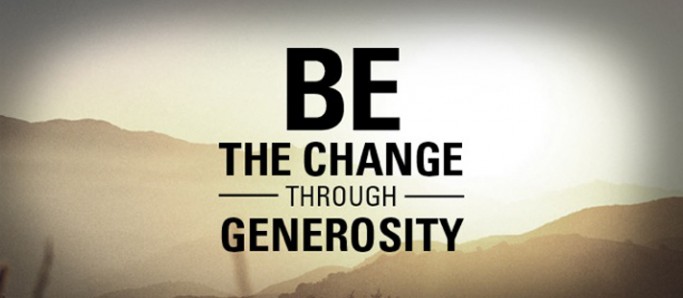
Why Donating 2% of Profits to Charity is Such a Cop Out
Give a man a fish and you feed him for a day. Teach him to fish and you feed him for a lifetime. Revolutionize the fishing industry and he can enrich his community of stakeholders for generations. That’s social impact. That’s the power entrepreneurs have when we choose to solve problems through generosity rather than charity.
We were at TOM’s Shoes recently touring their massive 70,000 square foot distribution center. TOM’s is recognized for doing a lot of good in the world. Raising awareness of international health issues and contributing to the elimination of foot borne diseases in developing countries. The downside to their well-intentioned charitable act of giving is that they’ve decimated entire industries in the countries they are trying to help.
TOM’s is supposed to be a great story for societal impact. Yet if you’re giving away millions of pairs of free shoes to Africa, what happens to all the manufacturing plants in Africa? Well, they’re bankrupt. What about all the local retail stores that sell shoes? Why buy when you can get it for free?
Contrast that with the unreasonable approach taken by our good friends at Lunapads. This Canadian B Corp company now has 65 employees in Africa manufacturing bio-degradable menstrual pads. They are making a difference in the world by contributing to the economies of companies. We’re not saying what TOM’s is doing is bad or evil, but the “one-for-one” approach is shortsighted. It’s great for awareness but it doesn’t contribute to sustainable economic and environmental practices.
Charity Only Assuages Guilt - It Doesn’t Build Capacity
The days of companies donating 2% of profits to charity, is over. As entrepreneurs, we need to contemplate social impact – not charity, as being the change we want to see in the world.
So what’s the difference? Charity is “I win and I give some away. I create abundance for myself and then I’m generous.” Social impact is a whole new way of thinking. “What if I went to Africa and actually contributed to the manufacturing facilities by enhancing their ability to be first world standard factories? Allowing them to develop an economy around my product, and then help them expand their customer base to increase their economies of scale so they can have distributers all over the world.”
Creating Shared Value
In 2011 Michael Porter and Mark Kramer published an article in the Harvard Business Review comparing the benefits of Fair Trade with increasing Shared Value. Fair Trade is a concept that distributes wealth to poorer farmers by paying them first world wages. This increases farmer’s wealth by about 10%. Shared value is something else entirely. Instead of concentrating strictly on wages, what if you increased yield efficiencies, introduced crop rotation strategies and better farm management practices? Early reports indicate this increases farmer’s wealth by 300%. And it’s not just socially conscious companies that have embraced the idea. Corporations known for their hard-nosed approach to business have begun to take notice.
What’s Good For The World Is Good For Business
Nestlé, for example, redesigned its coffee procurement processes, working intensively with small farmers in impoverished areas who were trapped in a cycle of low productivity, poor quality, and environmental degradation. Nestlé provided advice on farming practices; helped growers secure plant stock, fertilizers, and pesticides; and began directly paying them a premium for better beans. Higher yields and quality increased the growers’ incomes, the environmental impact of farms shrank, and Nestlé’s reliable supply of good coffee grew significantly. Shared value was created.
So here is our challenge. How could your company revolutionize your particular industry? Because you could be the one that changes everything.

I applaud the idea that business can and should serve to improve the lives of-really everyone-it comes into contact with. This is a vision of social entrepreneurship that makes me practically giddy: the most ingenious people striving to make a real difference in the world and showing us all the way forward. Kudos to you for promoting it so mightily.
I appreciate your acknowledgement of Nestle’s “hard nosed” approach to business however, I think that “hard nosed” is too weak a descriptor for Nestle and to my mind they have a very long way to go to show that they have a genuine interest in creating shared value.
Institute B on the other hand gets my vote now.
cheers.
Thanks for your kind words Matt. With respect to your comments about Nestle, is a commitment to creating shared value part of their DNA? We doubt it.
What they have learned however, is something we’ve been saying all along. What’s good for the world IS good for business. They have acknowledged that it is far more beneficial (read profitable) for them to increase shared value among their supply chain than not. While on the surface this appears to be motivated by profit, rather than from the intention of helping make the world better, they are in fact doing just that. At least in this instance. Social entrepreneurship is the future of business. It’s gratifying to see old school business finally grasping that reality.
Thanks for every other informative blog. Where else could I am getting that kind of info written in such a perfect means?
I have a undertaking that I am simply now working
on, and I have been at the glance out for such info.
Nice blog! Is your theme custom made or did you download it from somewhere?
A theme like yours with a few simple tweeks would really make my blog
jump out. Please let me know where you got your theme.
Thanks
Thanks for the compliment! We designed it.